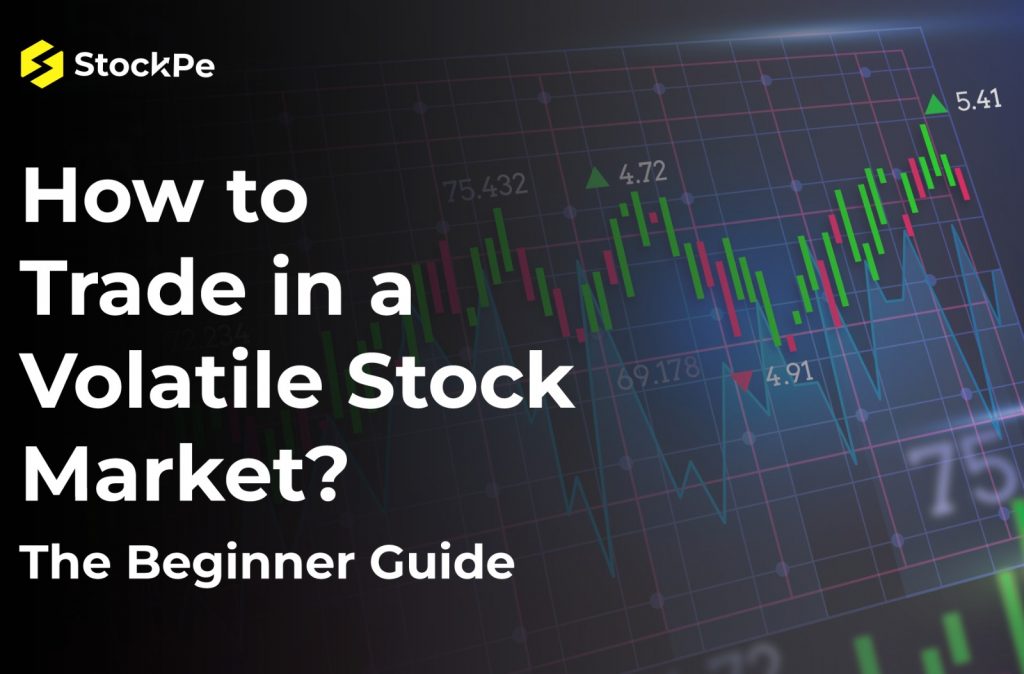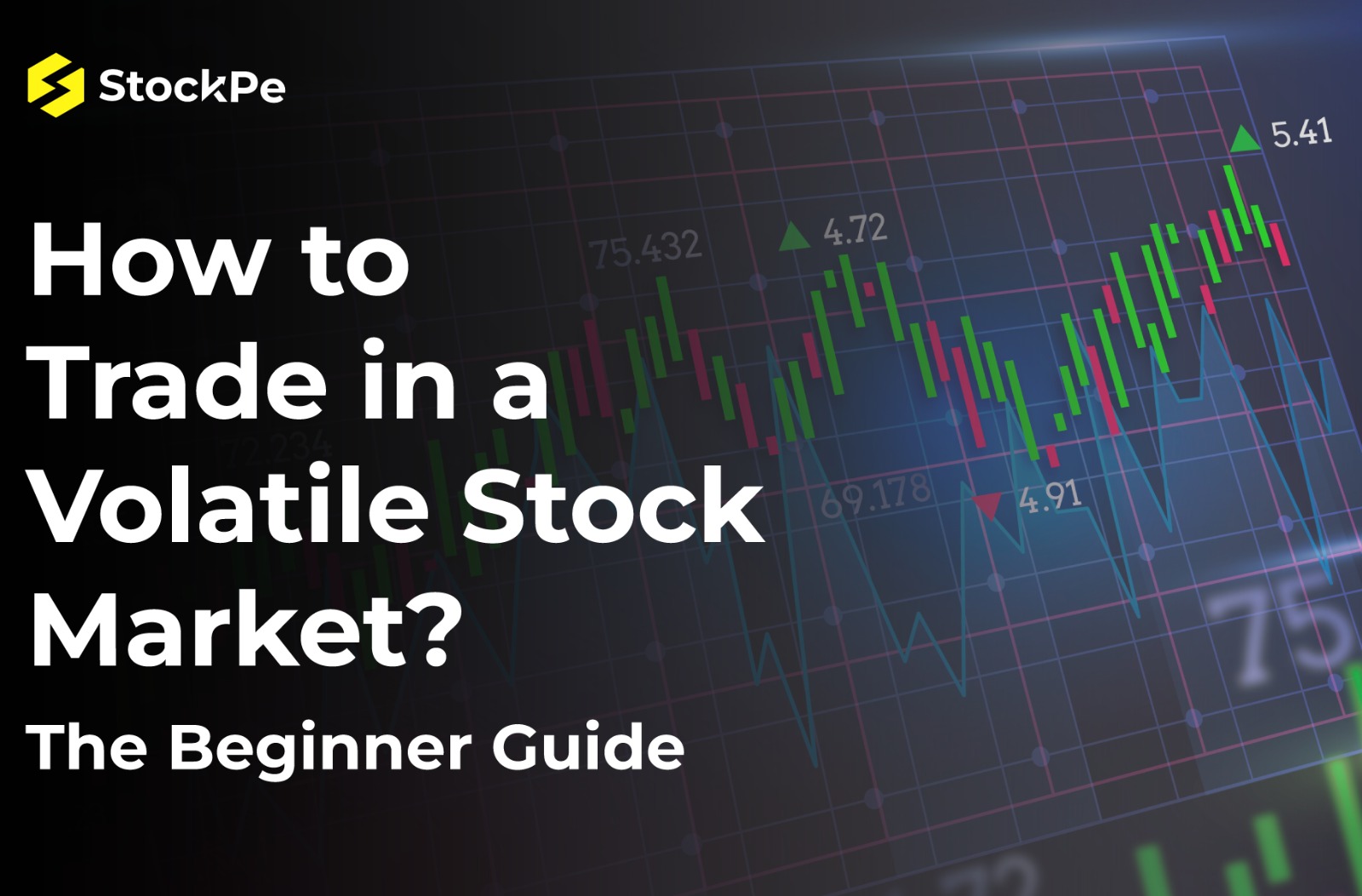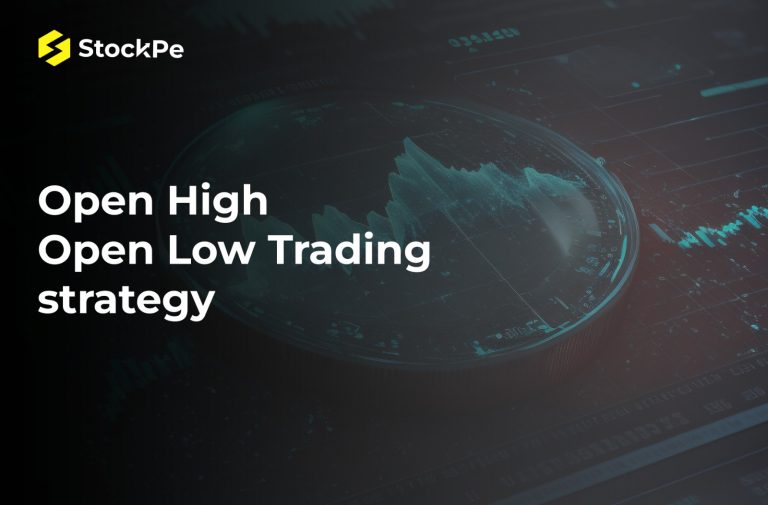The stock market is a place where investors buy and sell stocks to earn a profit. But, sometimes the market can be extremely volatile, with prices swinging wildly up and down in a short period of time. Volatile markets can be especially challenging for beginner traders. However, with proper guidance and strategies, one can take advantage of a volatile market to make a profit.
In India, the stock market is one of the most active and dynamic in the world. The two major stock exchanges, the National Stock Exchange (NSE) and the Bombay Stock Exchange (BSE), are home to thousands of companies and attract a large number of investors every day.

What can affect a market?
The market can be affected by a range of factors such as economic policies, global events, and company-specific news. In India, the stock market has experienced its fair share of volatility over the years, with events such as demonetization, the implementation of GST, and the COVID-19 pandemic causing significant fluctuations in the market. All of these factors contribute to the volatility of the market.
Here’s a beginner’s guide to trading in a volatile stock market in India:
Understand Volatility and its Causes
Volatility refers to the magnitude and frequency of price movements in a market or stock. When a stock is volatile, its price swings more widely than usual. This can make it challenging for traders to predict future price movements.
There are several factors that can cause volatility in the stock market, including economic events, political events, natural disasters, and changes in industry trends. In India, political events such as the Union Budget announcement, RBI policy, and state elections can have a significant impact on the stock market.
Use Technical Analysis
Technical analysis is a method of analyzing stock prices and identifying patterns that can help predict future price movements. It involves using charts and other tools to identify trends, support and resistance levels, and other indicators that can provide insight into the direction of the market.
In a volatile market, technical analysis can be particularly helpful as it can help traders identify price trends and potential reversal points. Traders can use tools such as moving averages, Bollinger Bands, and the average true range (ATR) to identify volatility levels and make informed trading decisions.
Understand the Average True Range (ATR)
One of the most useful tools for traders in a volatile market is the Average True Range (ATR). The ATR is an indicator that measures the level of volatility in a stock over a given period of time. It gives traders an idea of the expected range of price movement for a particular stock. Understanding the ATR can help traders set appropriate stop loss levels and target prices.
Moving Averages
Moving averages are a popular tool used in the stock market to help investors and traders understand the overall trend of a stock or market. It’s like a line that moves with the stock price and helps you figure out whether the stock is going up, down, or sideways.
Here’s how it works: let’s say you want to know whether a particular stock is on an upward trend. You can use a moving average to smooth out the stock’s daily fluctuations and highlight the overall trend.
For example, a 20-day moving average will add up the stock’s daily closing prices for the past 20 days and divide the total by 20 to get an average price. This average price is then plotted on a chart as a line that moves with the stock price.
How can you predict a trend?
If the stock’s current price is above the moving average line, it suggests an uptrend. If the current price is below the line, it suggests a downtrend. And if the current price is close to the moving average line, it suggests a sideways trend.
Moving averages can be helpful in identifying trends and making trading decisions. But like all tools, they have limitations and should be used in conjunction with other analysis and indicators. It’s also important to note that moving averages are backward-looking and can’t predict future prices with certainty.
Moving averages are a simple yet powerful tool that can help you understand the overall trend of a stock or market. They can be a helpful addition to your trading toolkit.
Daily Moving Average (DMA)
Imagine you have a toy car that moves around a track. Every day, you measure how far the car has traveled and write it down. After a few days, you have a list of distances the car has traveled.
Now, imagine you want to know how fast the car is going on average over the last few days. To do this, you could calculate what’s called a “daily moving average.” This is a way to find the average (or typical) distance the car traveled each day, but only looking at a certain number of days at a time.
For example, let’s say you want to find the daily moving average of the last three days. You would add up the distances traveled on each of those days and divide by three (since there are three days). This gives you the daily moving average for those three days.
How?
The next day, you would add the distance traveled on that day to your list, and drop the oldest day’s distance from your calculations. So, if you’re still looking at the last three days, you would drop the distance from four days ago and calculate a new daily moving average using the distances from the last three days.
By doing this, you can track how the car’s speed (or distance traveled) changes over time. In the stock market, traders use daily moving averages to track the average price of a stock over a certain number of days. If you are an investor, this helps you see if the stock’s price is generally going up or down, and can help them make better trading decisions.
Bollinger Bands
Bollinger Bands are a tool that investors use to analyze the movement of a stock’s price. They’re named after the person who created them, John Bollinger.
Bollinger Bands consist of three lines on a chart. The middle line is a moving average of the stock’s price over a certain period of time. The other two lines are plotted above and below the moving average, at a distance of two times the standard deviation of the stock’s price.
How are Bollinger Bands calculated?
The standard deviation is a statistical measure of how much the stock’s price varies from the average price. By using the standard deviation, Bollinger Bands give investors an idea of how much the price of a stock is likely to move up or down.
When the stock’s price is moving within the Bollinger Bands, it is considered to be trading within a “normal” range. If the price moves outside of the upper or lower Bollinger Band, it may be a sign that the stock is overbought or oversold, respectively.
What is the insight you can derive from Bollinger Bands?
In other words, Bollinger Bands can help investors identify potential buying and selling opportunities. If the price of a stock has been trending upwards and then touches the lower Bollinger Band, it could be a signal that the stock is undervalued and may be a good buy. Conversely, if the price of a stock has been trending downwards and then touches the upper Bollinger Band, it could be a signal that the stock is overvalued and may be a good sell.
Bollinger Bands are a useful tool for investors to help them make informed decisions about buying and selling stocks.
Don’t Try to Time the Market
It’s tempting to try to time the market by buying low and selling high, but it’s a risky strategy. In a volatile market, prices can move up and down rapidly, making it difficult to predict the right time to enter or exit a trade. Instead, traders should focus on finding good opportunities and using appropriate stop loss levels to limit their risk.
Have a Trading Plan
Having a trading plan is essential in any market, but it’s especially important in a volatile market. A trading plan should include your goals, risk tolerance, entry and exit points, and stop-loss orders.
In a volatile market, it’s important to set realistic goals and be prepared for sudden price movements. Traders should also be prepared to adjust their trading plan if market conditions change.
Keep an Eye on the Volatility Index
The volatility index, also known as the VIX, is a measure of the level of volatility in the overall market. In India, the Nifty volatility index (India VIX) is used to measure market volatility. The index is based on the options prices of the Nifty 50 index and gives an idea of the expected level of volatility in the market over the next 30 days. Traders should keep an eye on the volatility index to gauge the level of risk in the market.
Be Prepared for Price Swings
In a volatile market, prices can swing up or down rapidly, sometimes even in a single trading day. This can be stressful for traders, but it’s important to be prepared for price swings and not let emotions drive trading decisions. Traders should have a clear strategy in place and stick to it, even if the market is moving against them.
Use Stop Loss Orders
Stop loss orders are a useful tool for traders in a volatile market. A stop loss order is an order placed with a broker to sell a stock when it reaches a certain price. This can help limit the trader’s losses in case the price moves against them. Traders should set appropriate stop loss levels based on the level of volatility in the stock they are trading.
Traders should place stop-loss orders at a level that makes sense for the specific stock they are trading and their risk tolerance. Stop-loss orders can also be used in combination with other trading strategies, such as trailing stop-loss orders.
Trailing Stop-Loss Orders:
Trailing stop loss orders are a type of order that you can place when buying or selling a stock. It’s a way to protect yourself from big losses while still allowing your investment to grow.
Here’s how it works. Let’s say you buy a stock at Rs.50 per share. You want to protect yourself in case the price goes down. You can set a trailing stop loss order at, say, 10%. That means if the stock drops to Rs.45 per share. Then, the order will be triggered, and your shares will be sold automatically.
However, if the stock price goes up, the trailing stop loss order will also go up. But it will always be 10% below the highest price it reached. So if the stock goes up to Rs.60 per share. Then the trailing stop loss order will now be at Rs.54 (10% below Rs.60). This way, you can potentially lock in some profits while still protecting yourself from losses.
Uses:
Trailing stop loss orders are a useful tool for investors who want to manage their risk and limit potential losses. It’s important to remember, though, that they are not a guarantee of profits or protection against all losses. It’s always a good idea to do your research and make informed decisions before investing in any stock.
Stop Loss Orders at StockPe
StockPe offers its users the ability to place stop loss orders. This is a powerful risk management tool for trading in the stock market. Stop loss orders are essentially instructions to your broker or trading platform to sell a stock if it falls to a certain price level, helping you limit your potential losses in a volatile market.
In StockPe, users can set stop loss orders for both long and short positions, and the orders can be either market or limit orders. With a market order, the stock will be sold at the best available price once the stop loss is triggered, while with a limit order, the user can specify the minimum price they want to sell the stock at.
Understanding Stop Loss
Stop loss orders can be particularly useful when trading in volatile markets. Because sudden price swings can cause significant losses if left unchecked. By setting a stop loss order, users can limit their potential downside while still participating in the market’s potential upside.
Lock in Profits with StockPe
StockPe also provides users with the ability to set trailing stop loss orders. This allows the user to set a stop loss order that will adjust automatically as the stock price moves in their favor. This can be a useful tool for locking in profits while still allowing the stock to potentially continue rising.
Stop loss orders are an important tool for any trader. StockPe provides its users with a range of options to help manage risk and protect their investments. Now you can place a stopp loss order in StockPe tournaments.
Look for Trending Markets
In a volatile market, it can be difficult to predict future price movements. However, traders can increase their chances of success by focusing on trending markets.
Hence it can be difficult to find a direction for individual stocks in a volatile market. However, some stocks may be trending up or down despite the volatility. Traders should look for stocks that are in a clear uptrend or downtrend and take advantage of the price movement.
Trending markets are markets where prices are moving consistently in one direction, either up or down. By focusing on trending markets, traders can identify potential entry and exit points and make more informed trading decisions.
Focus on Volatile Stocks
While trading in volatile markets can be risky, it can also provide opportunities to make a profit. Traders can focus on volatile stocks that are experiencing large price movements. However, traders should also be aware
How does StockPe weigh in?
StockPe is the first app in India to gamify stock education, making it the best learning platform for individuals who want to invest confidently in a volatile stock market. The app offers in-depth, gamified learning and practice with zero effort and zero money, providing an excellent platform for beginners and experienced investors alike to hone their trading skills.
The gamified journey on StockPe is designed to make learning about the stock market an enjoyable experience. Investors can learn through guided case studies and gamified video tutorials that help simplify complex concepts, making it easy to understand the fundamentals of trading in the stock market.
Practice trading at StockPe
One of the best features of StockPe is the ability to practice trading without using real money. The app provides users with virtual money that can be used to invest in real stocks. This feature allows investors to experiment with different trading strategies and see how they would perform in a real-world scenario, without the risk of losing any actual money.
StockPe also offers 24/7 support to users, ensuring that they have access to help whenever they need it. The app provides a range of features and tools that can help investors make informed decisions about their trades, including real-time data on stock prices, trading volume, and more.
In summary, StockPe is the best learning app to learn how to invest confidently in a volatile stock market. The gamified learning and practice with zero effort and zero money make it easy for anyone to learn the fundamentals of trading in the stock market. With the ability to practice trading without using real money and access to 24/7 support, StockPe provides investors with all the tools and resources they need to succeed in the stock market.





